The 14 Cuts Of Steak You Should Steer Clear Of Buying
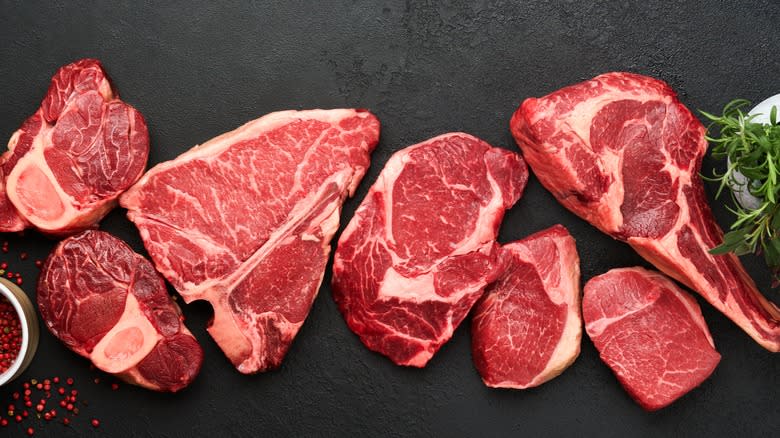
It can be difficult not to get overwhelmed at the meat counter these days, especially when trying to decide what cut of steak you should or shouldn't buy. It's easy to just grab whatever steak is cheapest or the one that matches a familiar name from the last steakhouse commercial you heard on television. While turning any cut of steak into something edible is by no means impossible, there are some cuts of steak you really should steer clear of unless there are no other options available.
When choosing which cut of steak to buy, it's first and foremost important to remember to check the meat's official USDA beef grade, as steak cuts marked "Prime" or "Choice" will nearly always yield tastier results than lower-graded beef steaks. While your own location may influence the availability (and therefore the prices) of the cuts below, as much consideration as possible has been given to the typical cost, flavor, and cooking skill needed when determining what cuts of steak can safely be ignored while preparing for your next cookout or family dinner.
Read more: Styles Of Regional BBQ In The US
Eye Of Round Steak

If you ever come across a slab of meat labeled "round steak" (or "eye of round," as it is sometimes known), you can feel free to ignore it completely. The round steak, while often cheaper than most other beef cuts, is one of the least popular cuts of steak for a good reason — it's incredibly lean and tough, lacking in flavor, and can easily be mistaken by someone uninformed or in a hurry for top round, which would lead to a disappointing dinner revelation later on.
Unlike the top-round cut of steak, which is more tender, bottom-round steak cuts have few redeeming qualities. Both sound similar and come from the same general hind leg portion of the beef, but it is worth remembering that according to the USDA, there are "six major sections" round cuts can be divided into. Round steak, whether it is made out of the eye of the round or the bottom round, is undeniably the least appetizing out of all of them. The only positive it can boast is that it is often cheaper than most other cuts of steak, but even this is not always the case.
Skirt Steak

When thinking about what cut of steak you should buy, skirt steak really only bears consideration if you are planning on feeding a large number of people who don't have the most judgmental taste buds or if you have a big cooking surface and great time management skills. Skirt steak is a very thin cut of steak made mostly of muscle from the beef's plate (the area inside the chest under the ribs), and it has a strong grain that must be cut against properly to ensure the meat doesn't become tough.
If you've ever been to a friend's Fajita Friday party and wondered why the beef strips were as rubbery as dog toys, an improperly cooked skirt steak is likely the cause. Where most people tend to go wrong with cooking skirt steak is when, because the cut of steak sold is often quite large despite being so thin, they improperly slice the steak into strips before cooking. This should never be done — instead, the whole cut of steak should be cooked on a grill or a pan at high heat to retain the juices of the meat.
Tri-Tip Steak
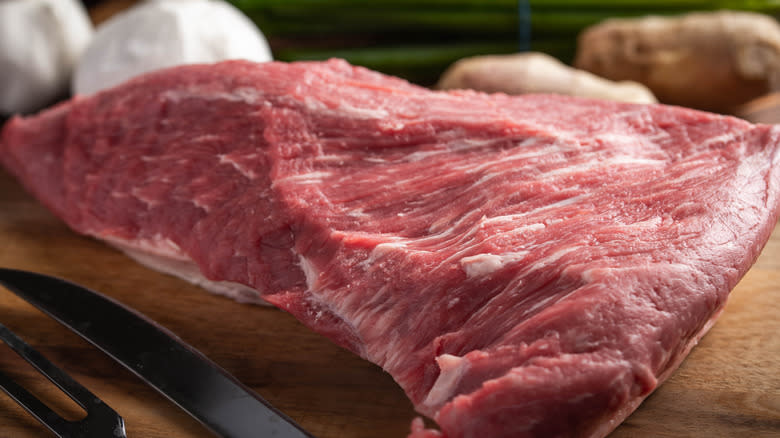
The tri-tip is another cut of steak anyone who is averse to micromanaging their food prep should avoid. Also known as a California cut, Santa Maria steak, or "poor man's brisket" by some, the tri-tip comes from the bottom sirloin and contains a bit more marbling than either the skirt steak or the round steak cuts, but its unique triangular shape makes it quite difficult to cook evenly. Because of this, the best grilled tri-top steak recipes always call for turning the meat often while it is on the grill. Unfortunately, it is still easy to overcook the edges even while the center of the tri-tip remains rare.
Tri-tip cuts of steak also contain both of the negative qualities of skirt steak cuts: a grain that needs to be sliced through properly for the meat to remain as delicious as possible and a tendency to become tougher and chewier than normal when overcooked. Tri-tip may also be more difficult to procure, depending on your region. Those living closer to California, the tri-tip steak cut's state of origin, will likely find it easier to acquire than those on the East Coast of the US and elsewhere.
Flank Steak

At first, it may not seem like there is much of a difference between flank steak and skirt steak. Flank steak shares many of the same negative aspects as skirt steak cuts, but if someone has to choose between buying one or the other at the supermarket, it is almost always a better decision to go with flank steak. While still quite lean, flank steak cuts are usually thicker and oblong, meaning it is somewhat easier to cook a flank steak to the proper temperature without the meat becoming too tough to chew, as long as all sides are braised properly.
Much like skirt steak, it is always best to cook the meat whole first and then cut the flank steak against the grain into strips only when the meal is ready to be served to ensure the steak ends up juicy and tender. Because of the lack of marbling in the meat, improperly cooked or cut flank steak can end up being a jaw-tiring exercise for your guests. Fortunately, since flank steak comes from the area below the loin and sirloin of the beef, this steak cut often has a slightly better flavor profile than its thinner counterpart.
Cube Steak
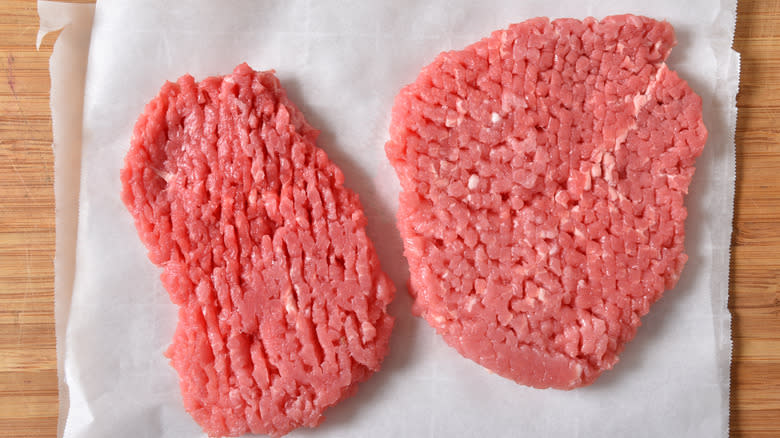
It's no surprise that at the time of writing, the current top "People Also Ask" result in Google for this steak cut is "How do you cook cube steak so it's not so tough?" Even though most cube steaks you find in the store have already been through a mechanical tenderizer, cube steak can be a difficult cut of beef to get right. This is because cube steak comes from the top round, which is a leaner cut of beef with less fat and more muscle.
Sometimes called "Swiss steak" or "minute steak" outside of the United States, cube steak is easily identifiable because of the holes that come from the tenderization process. Unfortunately, these same holes make it so the meat doesn't retain its juices while cooking as well as it should. Most cube steak instructions will call for extra liquid or generous amounts of gravy, but if you don't have any other cuts of steak available, the best thing to do would be to find a good chicken-fried steak recipe and just try to mask the meat as much as possible.
Chuck Steak

Chuck steak comes from the same part of the beef that is ground up to make hamburger meat and is one of the toughest cuts of steak out there. These cuts come from the forequarters of the beef, near the neck and shoulder area, and the meat is often quite lean because of the amount of exercise it gets. There are multiple different cuts of steak that come from this area of the animal, but chuck steak may be the one you should avoid the most.
Chuck steak can be grilled and served like a sirloin, but unless the meat has been marinated for a while, you would be better off using it in a stew. Chuck steak cuts are great for slow-cooking specifically because of how tough the meat is, and they also contain sinew and collagen, which will break down and mix with the liquid to create a thick, beef-flavored stew. If you're making a beef stew with chuck steak, it is recommended to season and pan-sear the meat first before slow-cooking it in a Dutch oven.
T-Bone Steak
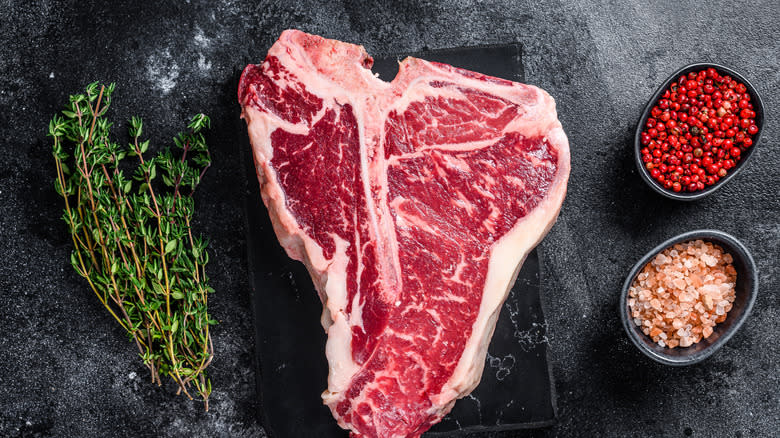
As the smaller, less quality version of a porterhouse steak, the T-bone steak cut might at first appear to be an odd inclusion here. However, T-bone steaks are a fairly overrated beef cut because they are difficult to cook evenly, and they don't provide a great money-for-meat ratio. T-bone steak cuts include both a New York strip cut and a tenderloin cut separated by the titular T-shaped bone, and it is this unique shape that makes the cut frustrating for some home cooks.
Because the side of the T-bone with the tenderloin has a lower fat content, it will cook slower than the strip side, so it is important to keep an eye on how much heat both corners of the T-bone are getting. This is why the T-bone is one of the cuts of steak to avoid buying unless you have a grill at home — it's not impossible to cook a T-bone on a stove properly if you own a good cast iron pan and an oven, but because the meat tightens and pulls itself inward during the cooking process while the bone stays rigid, it can be difficult to get an even sear on all parts of the steak.
Bavette Steak

Also known as flap meat or flap steak, bavette steak cuts can sometimes be mistaken for flank or skirt because of its odd shape, but it has a better flavor than either. It comes from a deeper, less exercised area of the beef than flank and skirt cuts do and is much more tender as a result. Bavette steak can be difficult to find whole, however, and because of its unique texture, you'll probably want to avoid buying cuts of flap steak strips.
The biggest trick to cooking a bavette steak properly is to ensure it isn't cooked rarely, which may already be a turn-off for some red meat lovers. Flap meat is incredibly mushy when rare due to the location of the cut, the fat content, and the wide grain of the beef, and cooking your bavette steak to at least a medium-rare temperature will achieve a much better texture and mouth feel. It's still important to use a high heat to get a good sear, and since you're likely to cook it longer than usual, it is a good idea to marinade the bavette steak ahead of time to increase its flavor.
Flat Iron Steak
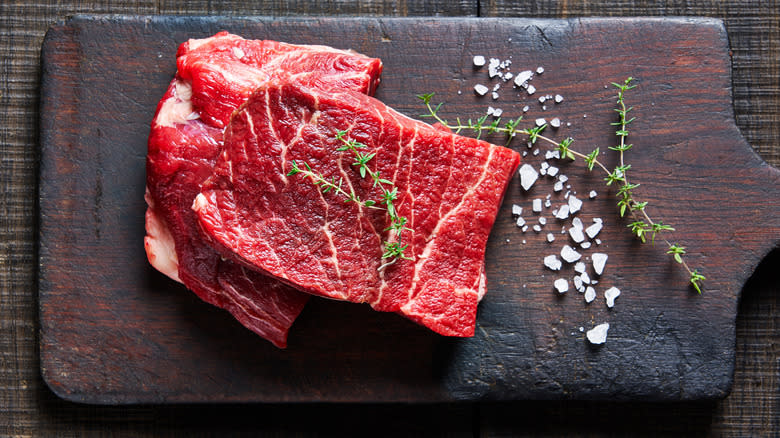
Flat iron steak has an interesting history and is one of the newer cuts of steak out there. It comes from a similar area of the beef as the chuck steak, but the specific part of the meat where the flat iron steak cut is located was considered unusable by butchers for decades. It wasn't until 2002 that the cut was discovered thanks to research from the University of Nebraska and the University of Florida focused on "cutting beef in a way to create single-muscle cuts or cuts that are consistent."
The flat iron steak, while very tender with a high-fat content, is also an extremely small cut of steak. This is what makes the flat iron a steak cut to avoid buying, as the cost often veers into "too expensive for the amount of meat you get" territory. The best way to cook flat iron steak, if you do end up splurging on this cut, is to grill it at a high heat to ensure a good, crispy exterior from the flames licking the burning fat.
New York Strip Steak
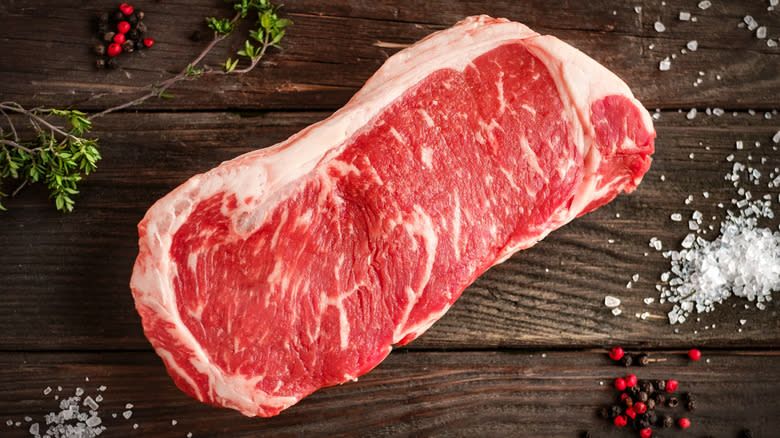
The New York strip cut is one of the most common types of steaks out there, and much like the T-bone it is occasionally attached to, the strip steak cut is a bit overrated. Previously, Chef Laurent Tourondel told Tasting Table New York strip steak was "hit-and-miss" and that he personally doesn't buy it because of this lack of consistency, which is due to the way strip steaks are sliced and the randomness in the marbling of the steak cut. "Sometimes it's nice. Sometimes it's chewy."
There's nothing especially outstanding about New York strip steaks, and they can really only be considered tender when compared to the worst offenders on this list. New York strip steaks have also gotten less affordable recently, and rising prices, likely coupled with this inconsistent quality, have led to nearly 50% of people cutting back on buying steaks altogether. Instead of gambling on a New York strip steak, it would be better to just buy something else.
Blade Steak

When deciding what cuts of steak to avoid buying at the grocery store, it's important to remember the entire family's food habits, and blade steak is one choice that might not be appreciated by younger members of the household. Named for the big vein of gristle which runs down the middle of the beef, blade cuts come from the same part of muscle as flat iron but are a more affordable cut of steak thanks to the gristle. While blade steak is more often smoked or braised, it is possible to grill a blade steak with some prep work.
If you are going to grill a blade steak, the best thing you can do is slice out the line of gristle inside the meat first. This obviously makes the meat appear more appetizing, but it also prevents the steak from becoming over-tough. When butchered and cooked to the proper temperature (no higher than medium rare), blade steak is one of the more tender cuts of steak available. If you don't remove the gristle ahead of time and cook blade steak any higher than medium, however, your jaw muscles won't appreciate it.
Picanha Steak
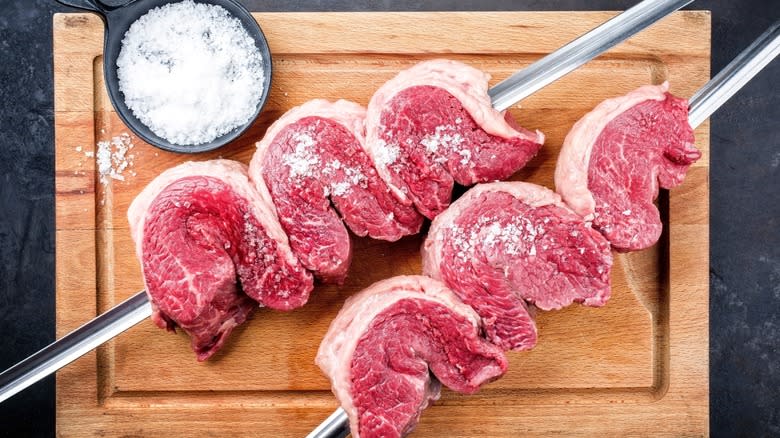
Another cut of steak that requires some prep work at home to make properly edible is the picanha steak. Sometimes known as top sirloin or rump cover in the US, picanha steak comes from the rump of the beef and can be sold with or without a large fat cap layer still attached. Since keeping the fat cap on offers better flavor throughout the cooking process, if you can't avoid buying picanha steak, at least make sure you get one with the fat still on.
Whether your meat has its fat cap or not, ultimately, you'll be getting a large chunk of picanha steak meat and cutting the individual slices of steak yourself, which gives you a few different options. Picanha steak cuts became quite popular in Brazil, where they were traditionally cooked on large skewers, but they can also be pan-seared or grilled. No matter whether you are cutting your picanha for skewering or for grilling out on the barbecue, it's important to note the meat should be sliced with the grain when making the individual steak slices and then cut against the grain when being served.
Denver Steak
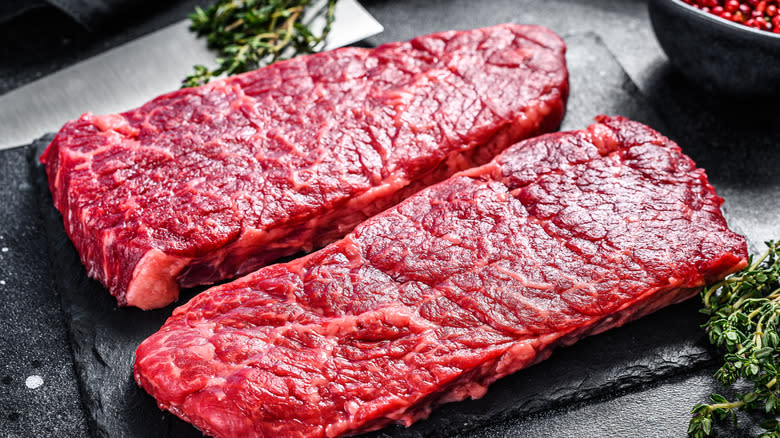
Denver steak is a hard-to-find steak cut that is normally only available online or if you let your butcher know you want one beforehand. If you do end up finding Denver steak in a grocery store, it will likely be overpriced due to the complicated nature of extracting it. Denver steak cuts come from deep within the chuck and are extracted from the beef as a single piece, with a technique The Spruce Eats describes as "more like surgery than carpentry."
After much effort just to create the steak cut, if you do end up with a Denver steak, it needs to be cooked and sliced appropriately to ensure it remains tender. Because of the high amount of marbling, the best way to handle these cuts of steak is either with a low heat followed by a reverse sear or a sous vide. Just remember that even when cooking a steak sous vide, it is important to get a good sear on it at the end, and never forget to slice against the grain when serving to preserve the butcher's hard work.
Tomahawk Steak

Tomahawk steak is delicious. Occasionally known as the bone-in ribeye and unmistakable from a distance, this steak cut comes from the loin of the beef and even looks impressive. It's also unwieldy, especially for home cooks who don't have access to a grill — and cooking a tomahawk steak on a grill will definitely give you the best result. Because of the large bone, tomahawk steak cuts contain many of the same negative qualities of T-bone and porterhouse steaks and need to be given the same considerations.
While grilling a tomahawk steak and then giving it a quick finishing high-heat sear on a pan might be one of the most delectable ways to enjoy steak out there, that deliciousness comes at a cost; tomahawk steaks are, hands-down, the least nutritious steak cut available. It may be a good choice for a one-off dinner party, but for a normal family meal, it is better to avoid buying steak cuts that have over a hundred grams of fat in a regular serving.
Methodology
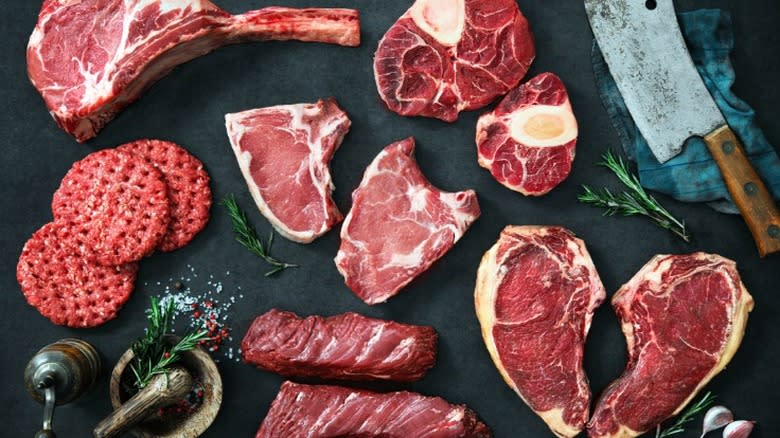
When determining what cuts of steak to avoid buying, a lot of consideration was given to the rising cost of meat prices versus the amount and quality of meat that each cut — when actually turned into a steak at home — ultimately delivers. Along with assessing value, we consider an individual cut's composition, from marbling to average density. Our selections were done through research of popular supermarkets, both local and online butchers, consumer reviews, and from my own personal experience as a former chef of nearly two decades. Anything can be made delicious with the right technique and equipment, but some steaks are always going to be more appealing to home cooks than others.
Read the original article on Tasting Table.

